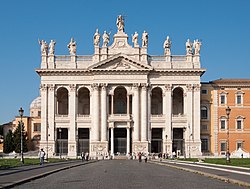
Back Latynse Kerk Afrikaans Lateinische Kirche ALS الكنيسة اللاتينية Arabic Лацінская Царква Byelorussian Лацінская Царква BE-X-OLD Església llatina Catalan Římskokatolická církev Czech Lateinische Kirche German Λατινική Εκκλησία Greek Latina eklezio Esperanto
Latin Church | |
|---|---|
| Ecclesia Latina | |
 Archbasilica of Saint John Lateran in Rome, Italy | |
| Type | Particular church (sui iuris) |
| Classification | Catholic |
| Orientation | Western Christianity |
| Scripture | Bible |
| Theology | Catholic theology |
| Polity | Episcopal[1] |
| Governance | Holy See |
| Pope | Francis |
| Full communion | Catholic Church |
| Region | Mainly in Western Europe, Central Europe, the Americas, the Philippines, pockets of Africa, Madagascar, Oceania, with several episcopal conferences around the world |
| Language | Ecclesiastical Latin |
| Liturgy | Latin liturgical rites |
| Headquarters | Archbasilica of Saint John Lateran, Rome, Italy |
| Territory | Worldwide |
| Origin | 1st century Rome, Roman Empire |
| Separations |
|
| Members | 1.2 billion (2015)[2] |
| Other name(s) |
|
| Official website | Holy See |
| Part of a series on |
| Particular churches sui iuris of the Catholic Church |
|---|
| Particular churches are grouped by liturgical rite |
| Alexandrian Rite |
| Armenian Rite |
| Byzantine Rite |
| East Syriac Rite |
| Latin liturgical rites |
| West Syriac Rite |
|
Eastern Catholic Churches Eastern Catholic liturgy |
| Part of a series on the |
| Catholic Church |
|---|
 |
| Overview |
|
|
| Part of a series on |
| Christianity |
|---|
 |
The Latin Church (Latin: Ecclesia Latina) is the largest autonomous (sui iuris) particular church within the Catholic Church, whose members constitute the vast majority of the 1.3 billion Catholics. The Latin Church is one of 24 churches sui iuris in full communion with the pope; the other 23 are collectively referred to as the Eastern Catholic Churches, and have approximately 18 million members combined.[3]
The Latin Church is directly headed by the pope in his role as the bishop of Rome, whose cathedra as a bishop is located in the Archbasilica of Saint John Lateran in Rome, Italy. The Latin Church both developed within and strongly influenced Western culture; as such, it is also known as the Western Church (Latin: Ecclesia Occidentalis). It is also known as the Roman Church (Latin: Ecclesia Romana),[4][5] the Latin Catholic Church,[6][7] and in some contexts as the Roman Catholic Church (though this name can also refer to the Catholic Church as a whole).[8][a] One of the pope's traditional titles in some eras and contexts has been the Patriarch of the West.[9]
The Latin Church was in full communion with what is referred to as the Eastern Orthodox Church until the East-West schism of Rome and Constantinople in 1054. From that time, but also before it, it became common to refer to Western Christians as Latins in contrast to Byzantines or Greeks.
The Latin Church employs the Latin liturgical rites, which since the mid-20th century are very often translated into the vernacular. The predominant liturgical rite is the Roman Rite, elements of which have been practiced since the fourth century.[10] There exist and have existed since ancient times additional Latin liturgical rites and uses, including the currently used Mozarabic Rite in restricted use in Spain, the Ambrosian Rite in parts of Italy, and the Anglican Use in the personal ordinariates.
In the early modern period and subsequently, the Latin Church carried out evangelizing missions to the Americas, and from the late modern period to Sub-Saharan Africa and East Asia. The Protestant Reformation in the 16th century resulted in Protestantism breaking away, resulting in the fragmentation of Western Christianity, including not only Protestant offshoots of the Latin Church, but also smaller groups of 19th-century break-away Independent Catholic denominations.
- ^ Marshall, Thomas William (1844). Notes of the Episcopal Polity of the Holy Catholic Church. London: Levey, Rossen and Franklin.
- ^ McAleese, Mary (2019). Children's Rights and Obligations in Canon Law: The Christening Contract. Brill Publishers. ISBN 978-90-04-41117-3.
- ^ Anderson, Jon (7 March 2019). "The beautiful witness of the Eastern Catholic Churches". Catholic Herald. Archived from the original on 29 September 2019. Retrieved 29 September 2019.
- ^ Turner, Paul (2007). When other Christians become Catholic. Liturgical Press. p. 141. ISBN 978-0-8146-6216-8.
When other Christians become Catholic: the individual becomes Eastern Catholic, not Roman Catholic
- ^ Fortescue, Adrian (1910). "Latin Church"". Catholic Encyclopedia.
no doubt, by a further extension Roman Church may be used as equivalent to Latin Church for the patriarchate
- ^ Faris, John D. (2002). "The Latin Church Sui Iuris". Jurist. 62: 280.
- ^ Ashni, A. L.; Santhosh, R. (December 2019). "Catholic Church, Fishers and Negotiating Development: A Study on the Vizhinjam Port Project". Review of Development and Change. 24 (2): 187–204. doi:10.1177/0972266119883165. ISSN 0972-2661. S2CID 213671195.
- ^ Turner, Paul (2007). When other Christians become Catholic. Liturgical Press. p. 141. ISBN 978-0-8146-6216-8.
When other Christians become Catholic: the individual becomes Eastern Catholic, not Roman Catholic
- ^ Mancini, Marco (11 August 2017). "Patriarca d'Occidente? No grazie, disse Benedetto XVI" [Patriarch of the West? No thanks, said Benedict XVI]. ACI Stampa (in Italian). Vatican City. Retrieved 28 November 2023.
- ^ Fortescue, Adrian (1914). Ward, Bernard; Thurston, Herbert (eds.). The Mass: A Study of the Roman Liturgy. The Westminster Library (New ed.). London: Longmans, Green and Co. p. 167.
Cite error: There are <ref group=lower-alpha> tags or {{efn}} templates on this page, but the references will not show without a {{reflist|group=lower-alpha}} template or {{notelist}} template (see the help page).